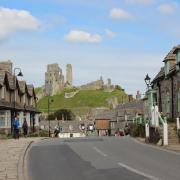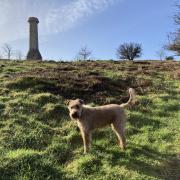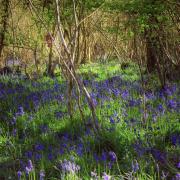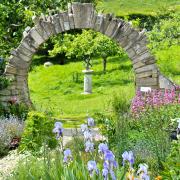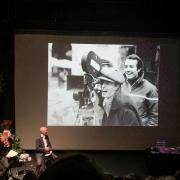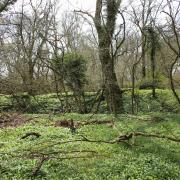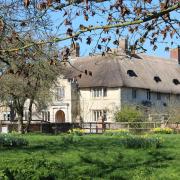One hundred years ago in 1924, scholarly musicologist Sylvia Townsend Warner finished writing her first novel Lolly Willowes. It wasn’t published until 1926, but its success propelled her into 1920s London literary society, including Virginia Woolf who admired Sylvia, her work and style. Her second novel Mr Fortune’s Maggot was equally critically acclaimed when published in 1927. In her lifetime, Sylvia Townsend Warner published five more novels, hundreds of short stories and countless poems, and became good friends with the writer Theodore Powys who moved to Chaldon Herring in 1904. In 1930, Sylvia was living part-time in Chaldon Herring in ‘Miss Green’, the little cottage which she named after its previous owner, opposite The Sailor’s Return, which is still serving pints today. Here, she began a lifelong ‘marriage’ with younger fellow-poet Valentine Ackland whilst sharing occupation of the cottage. They often strolled to the ‘Five Marys’ barrows on the north ridge overlooking the cottage and the village. Valentine died in 1969 and Sylvia in 1978, both at the riverside house outside Maiden Newton where they had lived since 1937. Their ashes are together in St Nicholas’ churchyard at Chaldon Herring; the plaque reads ‘non omnis moriar’ meaning ‘I shall not wholly die’.
On this scenic ramble, we follow where Sylvia, Valentine, Theodore and his wife Violet often walked, taking in the same glorious coast and chalk downland country with stunning panoramas west over Ringstead Bay to the Isle of Portland, and east beyond Lulworth Cove to St Aldhelm’s Head in Purbeck. East and south of the highest point (580ft) on Chaldon Down, there are unusually well preserved ‘Celtic’ (Bronze Age) fields. The parish has 33 barrows, and we pass close by one of the largest, Wardstone Barrow, 44ft diameter and 6ft high. Excavations in 1867 revealed a single cremation urn with a stone cover.

The Walk
1. From the village’s triangular green, walk south-south-west (SSW) up the West Chaldon lane to the church, and continue up the hill past right Old Vicarage and left Beth Car, Theodore Powys’ house. Continue between fields with views backward-right to the thatched Sailor’s Return. Keep straight on for another mile, passing the right flint-walled converted barn. Then, with Chaldon Hill right, pass one left cottage, then another, Number 24 which Sylvia and Valentine rented between 1934 and 1937. Approaching West Chaldon, before a right bend which heads towards left barns and right cottages, go through the backward-left 1½ bridleway-signed gates. Follow the meandering grassy track, fenced left and banked right. Before a bend, turn off right to 1½ gates bridleway-signed back ‘West Chaldon’. West Chaldon was formerly a manor and distinct parish. When the church become desecrated, the living, and rectory, was consolidated with the vicarage at Chaldon Herring in 1446.

2. Through into the vast field, walk straight up to the crown of the hill. Passing the right ‘Ringstead and White Nothe’ bridleway-post, continue straight up again, noticing a chalk quarry right. This large field covers the hill’s dome completely. Keep straight on over and down to the hedge’s bridleway-arrowed gap left of the electricity post. Through, walk straight across the long narrow field, aiming for the next hedge-gap with a bridleway-arrow left. Through into the next field, bear half-left (SW), diagonally under overhead cables, to the grass track running right/left at a bridleway-post. Turn left towards a ruinous steel-barn. The bridleway runs past its right end but is always abounding in nettles and other wild plants. Just push through and continue along the sparse right hawthorn hedge.

3. When you reach the left-right bridleway-arrowed 1½ fence-gates with views right over Holworth House to Weymouth, go through onto the flint track (three bridleway arrows outside) with ‘West Chaldon 1’ back-pointing milestone. Turn left up to 1½ fence-gates. Through, continue up the open field track, around a right bend and up to the bridleway-post and ‘Daggers Gate and Lulworth’ milestone. Keep straight on along the now-grass track between fields, then fenced left before right fenced barrows. Continue into the fences’ tapering end and go through the 1½ gates into the large field with right milestone signed back ‘White Nose ½’ and forward ‘Daggers Gate 1¾’. In this large field, continue on the green track (fence over to left), with obelisk top showing down to your right.

4. Then meeting the left fence, pass three stone niches with carved seashells commemorating Theodore Powys (no plaques). Behind these is another obelisk. Expanding coastal views include Swyre Head, Dungy Head, the coast path beyond Lulworth Cove, and Portland backwards right. Now downhill, continue to the next 1½ bridleway-gates. Through, continue along the left fence. Just before the next fence’s gateway, go through the left half-gate, before the ‘East Chaldon 1’ milestone, into the fence-enclosed ‘Permissive Path’ grass track with electricity posts left. Keep straight on, passing left Wardstone Barrow. Past more barrows, descend into Chideock Farm’s yard. Take the left flint track between the flint-faced cottage and right barnyard.

5. Through the Permissive Path gate and another gate, descend the track, fenced between fields into a lovely green valley. At the bottom, pass a left ‘East Chaldon ¾’ milestone and half-gate, and right 2½ gates opposite another gate. Through another gateway, walk up the steepening track, past another right half-gate and left chalk quarry. Up through the Permissive Path gate and over the top, continue down, becoming hedged. Passing a right track with a ‘Lulworth Estate Permissive Path’ sign backward, continue down, hedged and passing right ‘Private’ drive, left thatched cottages, more right houses and left garages. Leaving Chydyock Road near Chaldon Herring’s triangular green, from where you return to your starting point in the village or at New Close car park.

Compass Points
Distance: 6 miles/9.5 km
Time: 4 hours
Start: St Nicholas’ Church, Chaldon Herring (Grid Ref: SY790832). Park in New Close car park along ‘Winfrith Newburgh’ road, signposted from village green ‘Car Park ¼’
Exertion: Fairly strenuous. A long slow ascent early on, then undulating before a long slow descent
Map: OS Landranger Sheet 194
Public Transport: None
Dogs: On leads on roads, near livestock and ground nesting birds. Follow The Countryside Code
Refreshments: The Sailor’s Return, Chaldon Herring for real ales and good food




